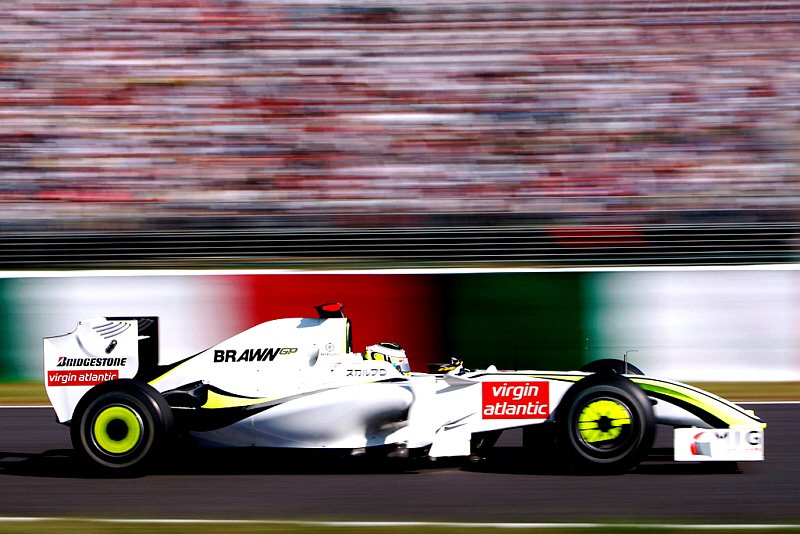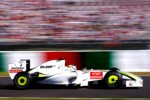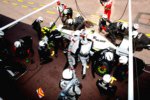|
One of the great things
about sports is the sheer unpredictability of the results. It is not
uncommon for the favourite to fail and the underdog to overcome
adversity. In a tightly regulated sport like Formula 1 there is
unfortunately little room for surprises. The successful teams can
develop their winning cars often creating bigger gaps with the
competition. Only drastic rule changes can upset the status quo with
immediate effect. The start of the 2009 season was a prime example when
for once the underdog stole the show. Winning six of the first seven
races, Jenson Button and the newly formed Brawn GP left the previous
year’s top runners well in their wake.
Just a few weeks before the first race of the season, this scenario
seemed absolutely impossible. Honda had withdrawn from Formula 1 late in
2008, offering their England based operation for sale. Although there
were various interested parties a new owner could not be found.
Eventually a management buy-out led by team principle Ross Brawn seemed
the only solution. Launched early in March, the ‘new’ team was labelled
Brawn GP and pretty much continued where Honda had left off. Compared to
the competition, the team was two months behind on testing. Nevertheless
seasoned drivers Jenson Button and Rubens Barrichello stunned observers
by their pace straight out of the box.
Perhaps forced by the bad economy or tired of the poor results, Honda
could not have timed their withdrawal worse. Very early on Brawn and his
men had decided to forget about 2008 and to concentrate all their
efforts on the new car instead. Dramatic changes to the aero and tire
regulations meant that the 2009 contender would require a virtual
clean-sheet design. Honda was the first team to start the developments
and had a clear head-start. Insiders already predicted a great year for
the team after so many dire seasons. When the Japanese manufacturer
announced it would cease the Formula 1 activities many feared we would
never get to see just how good the car was.
Three months later we did get to see the new machine. Painted in a white
with Day-Glo yellow stripes livery, the Brawn GP BGP001 was revealed at
the Silverstone circuit. Honda had also stopped the supply of engines
but fortunately Mercedes-Benz were able to increase their production. In
record time the Brawn GP engineers adapted the chassis to accommodate
the Mercedes V8 engine. The most controversial element of the car was
the ‘double decker’ diffuser. Even though Ross Brawn had already talked
about its legality with the FIA in 2008, many of the other teams were
convinced the diffuser was illegal. Toyota and Williams used similar
designs and obviously sided with Brawn GP. The protests overshadowed the
first races but came to nothing.
Although everybody knew the Brawn GP cars were very quick, few expected
the pre-season testing pace could be maintained during the race
weekends. The Brawn GP team could and in spectacular fashion. Even
though the team did not exist a month earlier, Button and Barrichello
piloted the striking and virtually sponsorless BGP001s to a one-two
victory during the season opening Australian Grand Prix. The previous
season’s top contenders McLaren and Ferrari both failed to score points.
Rarely had the tables turned so dramatically in Formula 1. As the season
progressed more and more sponsors were found but what maintained was
Button’s incredible form and the unusual white and yellow livery.
Button scored six wins in the first seven races and held a massive lead
in the standings. With one hand on the championship trophy, he and the
Brawn team hit a slump as the rest of the field caught up. The Adrian
Newey designed Red Bull RB5 emerged as the biggest challenger of
Button’s reign. Despite only scoring a few points for several races, the
rivals did not catch him hand over feet because each of these races had
a different winner. Barrichello also added two victories to his tally
after a five-year drought. As his lead gradually decreased, the pressure
on Button increased. In the penultimate race at Interlagos, he finally
clinched the title with a drive worthy of a world champion. The Brawn GP
team ended its fairytale season with the Constructor’s trophy as well.
Working on a tight budget, Brawn GP only built three chassis and Jenson
Button used the same car throughout his championship winning year.
Before Honda’s withdrawal a ‘RA109’ tub was constructed but that could
not be used with the Mercedes engine. Shortly after the 2009 season, it
emerged that this was a one-off season for Brawn GP as the team was
bought by Mercedes-Benz. The ‘Silver Arrows’ will not be piloted by
Barrichello and Button as they have left for Williams and McLaren
respectively. With nine wins in seventeen races and securing both
driver’s and constructor’s in their only ever season, the Brawn GP will
undoubtedly enter the history books as one of the most successful
Formula 1 teams ever.
|
![Brawn-GP-BGP001-Mercedes_21-800[1]](https://autobabes.com.au/wp-content/uploads/2009/11/Brawn-GP-BGP001-Mercedes_21-8001-678x381.jpg)







Be the first to comment